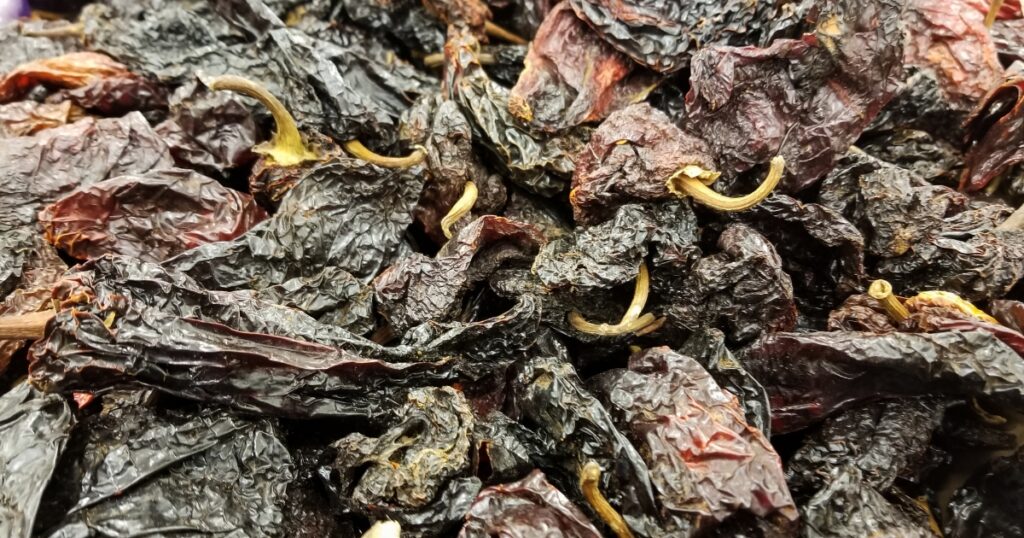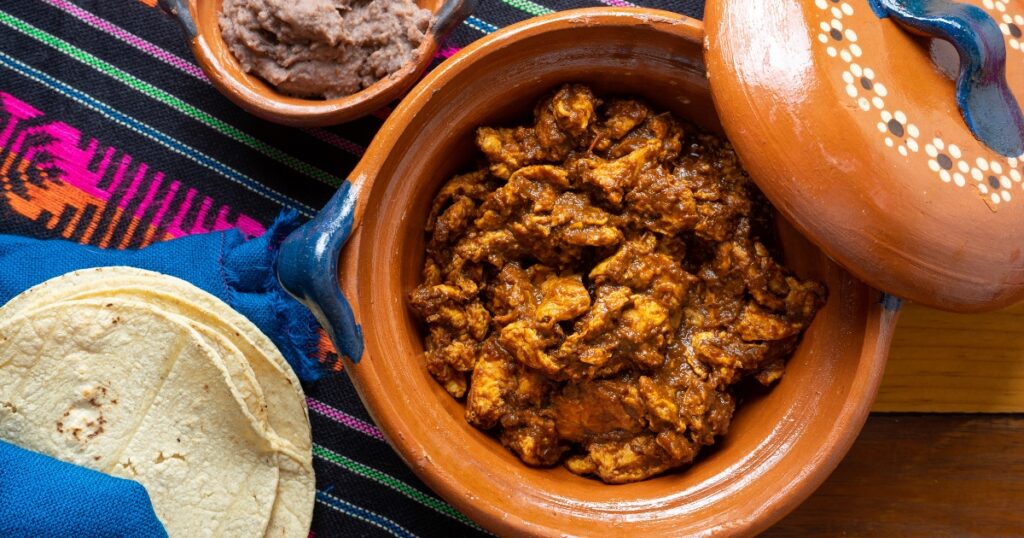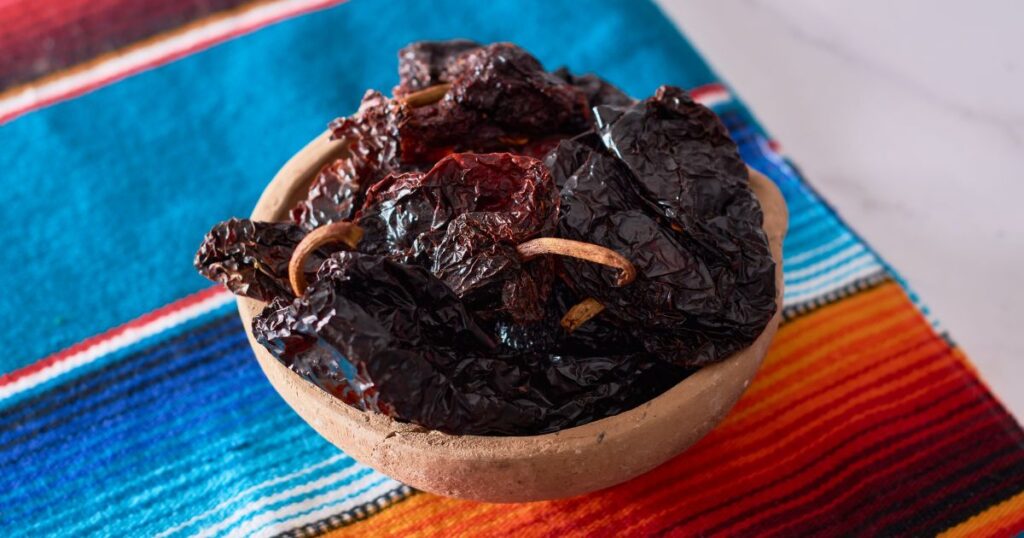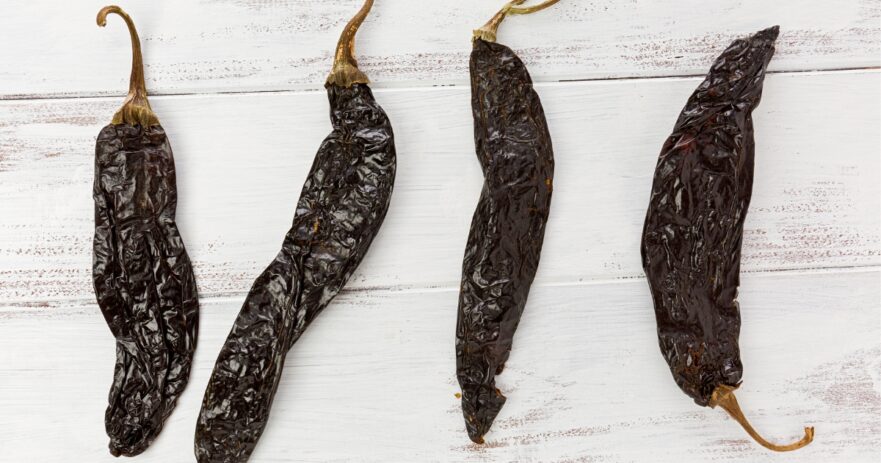In this article about Pasilla pepper:
🗺️ Origin and history | 🌶️ Uses | ✨ Appearance and taste | 🧑🌾 Growing – gardening | 👨🍳 Cooking – recipes | 🫙 How to store | 👨⚕️ Health benefits | 🌶️ Alternatives and substitutes | ❓ Frequently asked questions
What is a Pasilla pepper?
Pasilla pepper is a dried chili pepper native to Mexico. They are known for their rich, complex flavor profile. They are the dried form of Chilaca peppers, medium, slender, and dark green when fresh, turning to a dark brown or blackish color when fully ripened. When dried, they take on a deep, dark, brown-red color and are often called Pasilla Negro or Chile Negro.
Pasilla peppers have mild to moderate heat, ranging between 1,000 and 2,500 Scoville heat units. Their earthy, slightly fruity taste with hints of chocolate and raisin make them a popular ingredient in traditional Mexican cuisine. In addition, they are often used in mole sauces, soups, stews, and other dishes, adding depth and a touch of warmth to culinary creations.
| Pasilla pepper | |
| SHU | 1,000 - 2,500 |
| Median SHU | 1,750 |
| Flavor | Earthy and sligthly sweet and fruity, with a mild to moderate heat |
| Species | Capsicum annuum (Dried, ripe chilaca pepper) |
| Origin | Mexico |
| Uses | Sauces, moles, stews, soups, marinades, etc. |
Are Pasilla peppers spicy? How hot are they?
Pasilla pepper scoville: 1,000 to 2,500 SHU
As mentioned, the Scoville rating for Pasilla peppers ranges from 1,000 to 2,500 units, which indicates mild to moderate heat. For context, jalapeños have a Scoville rating between 2,500 and 8,000 units, while bell peppers rate zero, signifying no spiciness. In comparison, pepperoncini peppers rate 100 to 500 Scoville units, making them milder than Pasilla peppers.
Numerous alternatives are available for those seeking an option spicier than Pasilla peppers. For instance, Serrano peppers offer considerably more heat, and habanero peppers are even hotter. With the wide variety of peppers, there’s an option for every spice preference.
🗺️ ORIGIN AND HISTORY
Where do Pasilla peppers come from?
Pasilla peppers have their roots in Mexico, particularly in the country’s central and southern regions. These mild, flavorful peppers have been a cornerstone of Mexican cuisine for centuries, playing a vital role in traditional dishes and culinary techniques. Pasilla peppers are especially significant in mole sauces, a classic Mexican staple. Pasilla peppers gained recognition beyond Mexico and became popular in various global cuisines. Today, these versatile peppers are cultivated in Mexico and also globally, enriching culinary traditions with their unique flavor and mild heat.
🌶️ USES
What are Pasilla peppers good for? How to use them?
Pasilla peppers have numerous culinary applications, enriching dishes with their unique, mildly spicy flavor. In addition, their versatility makes them an excellent addition to recipes, elevating their taste and visual appeal.
Pasilla chiles are key in traditional Mexican mole sauces, imparting a deep, earthy flavor that balances the sweetness of the chocolate and spices. Dried pasilla chiles can be rehydrated and used in soups, stews, and other recipes, adding richness and depth to the dish.
Another common application for Pasilla peppers is ground pasilla chili pepper, also known as pasilla chile powder. This finely ground spice seasons various dishes, from savory meats and vegetables to more adventurous sweet dishes like chocolate desserts. In addition, Pasilla chile powder works as a rub for grilled meats or in marinades, providing a gentle heat and distinctive flavor that doesn’t overpower other ingredients.
Pasilla peppers can be incorporated into salsas and sauces, adding a mild kick that complements other components. In addition, the peppers’ fruitiness balances the acidity of tomatoes, making them excellent for fresh salsas or cooked sauces to accompany tacos, enchiladas, or other Mexican dishes.
Pasilla peppers can be utilized in soups and stews, adding complexity to their flavor. Their mild heat and earthy undertones make for a warm, comforting dish perfect for cold weather or when craving something hearty and satisfying.

✨ APPEARANCE AND TASTE
What do Pasilla peppers look like?
Pasilla peppers, also known as chile negro, are the dried form of Chilaca peppers. They are medium-sized, elongated chili peppers typically between 6 and 8 inches long and about 1 to 1.5 inches wide. They have a slightly curved, wrinkled appearance; meanwhile, their color varies from rich brown-reddish to nearly black. The skin of the Pasilla pepper is wrinkled and textured, showcasing its dried nature. The hollow cavity inside the pepper contains numerous small, edible seeds, as in other chili peppers.
How do Pasilla peppers taste?
Pasilla peppers possess a unique, mildly spicy, earthy, slightly fruity, and sweet flavor. They have a Scoville heat rating of 1,000 to 2,500 units, placing them on the milder side of the spectrum than other chili peppers. Their subtle spiciness enhances dishes without overwhelming other flavors.
When consumed fresh as Chilaca peppers, they have a crisp texture, and their taste can be described as mildly sweet and earthy with a hint of fruitiness. As the pepper dries and becomes a Pasilla pepper, its flavor becomes more concentrated; the earthy, fruity notes become more pronounced.
🧑🌾 GROWING – GARDENING
How to grow Pasilla peppers?
Growing Chilaca peppers, later dried to become Pasilla peppers, is a rewarding experience for many home gardeners. These medium-sized chili plants thrive in various climates and are relatively low-maintenance. They flourish best in warm weather with ample sunlight and can be grown in containers or garden beds. To ensure healthy growth, provide well-draining soil, consistent watering, and regular fertilization throughout the growing season.
When to pick Chilaca peppers for Pasilla peppers?
Observing the growth and development of Chilaca peppers is crucial in determining the perfect harvest time. Generally, Chilaca peppers are ready to harvest 75 to 90 days after planting. However, the harvest time will depend on the peppers’ intended use and maturity. To obtain Pasilla peppers, harvest the Chilaca peppers when they fully mature and have developed a deep brown color.
👨🍳 COOKING – RECIPES
Cooking/Recipe ideas for Pasilla peppers
Pasilla peppers are a popular ingredient in Mexican cuisine. They bring a rich, complex flavor to various dishes. In addition, their earthy, fruity notes and mild to moderate heat make them an ideal choice for various recipes.
Pasilla pepper chili is a comforting, warm dish perfect for cool evenings. Incorporate rehydrated and chopped Pasilla peppers into a chili recipe along with ground meat, beans, tomatoes, and spices. The Pasilla peppers will lend a fruity, mild heat to the chili, making for a delicious and unique twist on traditional chili.
Combine Pasilla peppers with Poblano peppers alongside tomatoes, onions, garlic, and lime juice for a flavorful salsa. This combination results in a salsa that balances the fruity, mild heat of Pasilla peppers with the fresh, slightly spicy taste of Poblano peppers. It’s a good idea to enjoy this salsa with chips or as a topping for tacos, grilled meat, or fish.
Pasilla peppers are versatile and can be used in other dishes, including soups, stews, and sauces. Experiment with Pasilla peppers to discover how their unique flavor can elevate your favorite recipes.
It’s worth noting that, in the United States, Poblano peppers are sometimes mistakenly referred to as Pasilla peppers, leading to confusion. For instance, the Stuffed Pasilla dish is made with Poblano peppers. This confusion also extends to Pasilla pepper casseroles, where Poblano peppers are used instead of dried Pasilla. To avoid any mix-up, double-check the recipe and ensure you use the correct pepper variety. Understanding the differences between Pasilla and Poblano peppers helps you create authentic and flavorful dishes.

🫙 HOW TO STORE
How do I store Pasilla pepper?
Dried Pasilla peppers can be stored for several months in the right conditions. Place Pasilla peppers in an airtight container or resealable plastic bag, and keep them in a cool, dark place like a pantry or cupboard. This helps preserve their flavor and texture for an extended period.
Ground Pasilla chili pepper, or chile powder, should also be stored in airtight containers to maintain freshness. Keep them away from direct sunlight and heat, which causes the powder to lose its potency and flavor over time.
Like other dried goods, Pasilla peppers can degrade in quality over time. Signs that they are no longer suitable for consumption include a musty odor, discoloration, or mold. If you notice any of these signs, it’s best to discard the peppers and replace them with fresh ones.
❤️🩹 HEALTH BENEFITS
Are Pasilla peppers healthy?
Dried Pasilla peppers are a beneficial and nutritious addition to your diet. These peppers provide a variety of essential vitamins and minerals that contribute to overall health. For example, dried Pasilla peppers are rich in vitamin A, which is crucial in maintaining good vision, supporting the immune system, and promoting healthy skin. Additionally, they contain B vitamins, iron, and manganese. However, it’s important to note that dried Pasilla peppers are more concentrated in flavor and nutrients than fresh peppers. So, you’ll typically use smaller amounts in recipes but still benefit from their nutritional profile.
In addition to their vitamin content, Pasilla peppers contain capsaicin, a compound known for its anti-inflammatory and pain-relieving properties. While Pasilla peppers are milder than other chili peppers, their capsaicin still offers health benefits, such as boosting metabolism and aiding digestion.
It’s important to note that some individuals may experience gastrointestinal discomfort after consuming spicy foods, including Pasilla peppers. If you experience discomfort after eating Pasilla peppers, reduce your consumption or avoid them entirely.

🔄 ALTERNATIVES AND SUBSTITUTES
What is a good Pasilla pepper alternative?
If you’re seeking a Pasilla pepper substitute, several options are available. Each provides distinct flavors and heat levels to suit your preferences or recipe requirements.
Ancho peppers are a popular alternative to Pasilla peppers, as both are dried forms of Mexican chilies. With a similar heat and a slightly sweeter flavor, Ancho peppers can be used interchangeably in recipes calling for Pasilla peppers, including mole sauces, chili, and stews.
Though hotter, Guajillo peppers are another alternative to Pasilla peppers. These peppers have a pronounced fruitiness and subtle smokiness. In addition, their earthy taste and uniquely pungent sweetness make them a suitable substitute in recipes that call for a mild, fruity heat with a spicier kick.
For a spicier substitute, consider using Chipotle peppers. These are smoked and dried jalapeño peppers; thus, they have more heat than Pasilla peppers with a distinct smoky flavor. They work well in sauces, stews, and chili recipes that require a smoky kick. Use Chipotle peppers sparingly, especially if you’re not accustomed to their spiciness.
Remember, when substituting for Pasilla peppers, the flavor of your dish may change slightly. Therefore, adjust the other ingredients accordingly to achieve the desired result.
How do you pronounce Pasilla pepper?
The accurate pronunciation of Pasilla pepper is pah-SEE-yah PEH-per.
🙋 FREQUENTLY ASKED QUESTIONS
FAQ about Pasilla peppers
Is Pasilla pepper spicy?
Pasilla peppers are mildly spicy, with a Scoville heat rating from 1,000 to 2,500 SHU. The heat level in these peppers makes them suitable for those who prefer mild to moderate spiciness in their dishes. In addition, pasilla peppers impart a rich, earthy flavor with subtle fruity undertones, meaning they are ideal for various culinary applications, including salsas, sauces, and soups.
Is Pasilla pepper the same as poblano?
Pasilla pepper and poblano pepper are not the same but are related. Pasilla pepper is the dried form of the Chilaca pepper, while poblano is a fresh, green pepper. Poblano peppers are larger and have thicker flesh, with a heat rating of 1,000 to 2,000 SHU. They are often used for stuffing due to their size and mild heat. Despite their differences, pasilla and poblano peppers are commonly used in Mexican cuisine. They can sometimes be substituted for one another in recipes depending on the desired flavor and texture.
Do you have to peel Pasilla peppers?
There can be some confusion between pasilla and poblano peppers, as poblano peppers are sometimes mistakenly referred to as pasilla peppers. However, it is important to note that poblano peppers have a thicker, fleshier skin that can be peeled off for a smoother texture. In contrast, pasilla peppers are usually sold in a dried form and do not require peeling.
So, if you use fresh poblano peppers, you can peel them by roasting or grilling them to char the skin. Then, place the peppers in a bowl, and cover them with a towel or plastic wrap for about 15 minutes, allowing the steam to soften the skin. Once cooled, gently rub the skin off using your fingers or a paper towel. This, in turn, helps achieve a smoother texture and better flavor absorption in your dishes.

